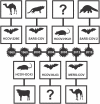COVID-19 During Development: A Matter of Concern
- PMID: 33898461
- PMCID: PMC8058409
- DOI: 10.3389/fcell.2021.659032
COVID-19 During Development: A Matter of Concern
Abstract
A new infectious disease, COVID-19, has spread around the world. The most common symptoms of severe acute respiratory syndrome coronavirus 2 (SARS-CoV-2) infection are cough and fever, but severe cases can develop acute respiratory distress syndrome. The main receptor for SARS-CoV-2 in human tissue is angiotensin-converting enzyme 2, and the lungs, heart, and kidneys are the most affected organs. Besides the inflammatory process and tissue damage, the presence of a cytokine "storm" has been related to a higher mortality rate. Other infectious viral diseases, such as Zika, chikungunya, and influenza, were associated with complications in pregnant women, such as growth restriction, malformation, preterm birth, low birth weight, miscarriage, and death, although they can also cause developmental disorders in infants and adolescents. Evidence points out that stressors during pregnancy and infancy may lead to the development of obesity, diabetes, and cardiovascular disease. Therefore, we hypothesize that COVID-19 infection during the critical phases of development can program the individual to chronic diseases in adulthood. It is important that COVID-19 patients receive proper monitoring as a way to avoid expensive costs to public health in the future.
Keywords: COVID-19; SARS-CoV-2; cardiometabolic disease; development; metabolic programming; public health.
Copyright © 2021 Saavedra, Prates, Gonçalves, Piovan, Matafome and Mathias.
Conflict of interest statement
The authors declare that the research was conducted in the absence of any commercial or financial relationships that could be construed as a potential conflict of interest.
Figures



Similar articles
-
Outcome of coronavirus spectrum infections (SARS, MERS, COVID-19) during pregnancy: a systematic review and meta-analysis.Am J Obstet Gynecol MFM. 2020 May;2(2):100107. doi: 10.1016/j.ajogmf.2020.100107. Epub 2020 Mar 25. Am J Obstet Gynecol MFM. 2020. PMID: 32292902 Free PMC article.
-
The effect of coronavirus infection (SARS-CoV-2, MERS-CoV, and SARS-CoV) during pregnancy and the possibility of vertical maternal-fetal transmission: a systematic review and meta-analysis.Eur J Med Res. 2020 Sep 4;25(1):39. doi: 10.1186/s40001-020-00439-w. Eur J Med Res. 2020. PMID: 32887660 Free PMC article.
-
Testing the efficacy and safety of BIO101, for the prevention of respiratory deterioration, in patients with COVID-19 pneumonia (COVA study): a structured summary of a study protocol for a randomised controlled trial.Trials. 2021 Jan 11;22(1):42. doi: 10.1186/s13063-020-04998-5. Trials. 2021. PMID: 33430924 Free PMC article.
-
Counseling in maternal-fetal medicine: SARS-CoV-2 infection in pregnancy.Ultrasound Obstet Gynecol. 2021 May;57(5):687-697. doi: 10.1002/uog.23628. Ultrasound Obstet Gynecol. 2021. PMID: 33724545 Free PMC article.
-
The origin, transmission and clinical therapies on coronavirus disease 2019 (COVID-19) outbreak - an update on the status.Mil Med Res. 2020 Mar 13;7(1):11. doi: 10.1186/s40779-020-00240-0. Mil Med Res. 2020. PMID: 32169119 Free PMC article. Review.
Cited by
-
The Development of SARS-CoV-2 Variants: The Gene Makes the Disease.J Dev Biol. 2021 Dec 15;9(4):58. doi: 10.3390/jdb9040058. J Dev Biol. 2021. PMID: 34940505 Free PMC article. Review.
-
Automated Medical Care: Bradycardia Detection and Cardiac Monitoring of Preterm Infants.Medicina (Kaunas). 2021 Nov 3;57(11):1199. doi: 10.3390/medicina57111199. Medicina (Kaunas). 2021. PMID: 34833417 Free PMC article.
References
-
- Al Shehri A. M. (2015). A lesson learned from Middle East respiratory syndrome (MERS) in Saudi Arabia. Med. Teach. 37 S88–S93. - PubMed
LinkOut - more resources
Full Text Sources
Other Literature Sources
Miscellaneous

